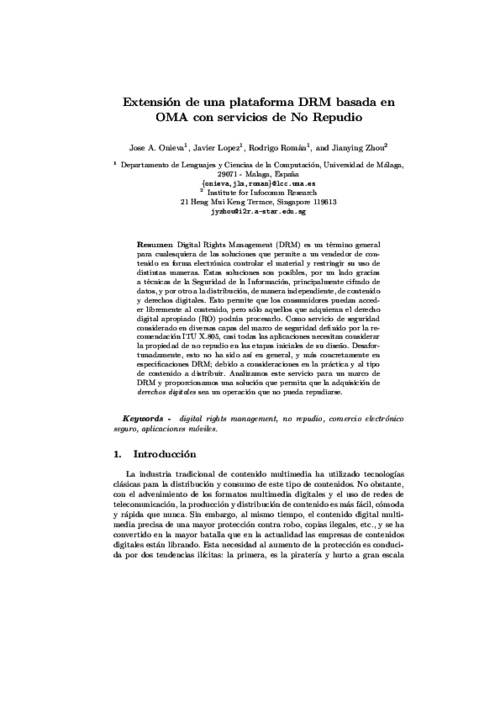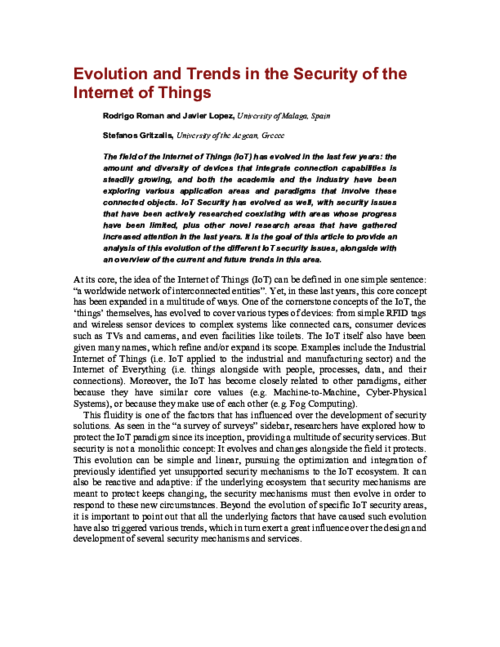 ] Type Year
] Type Year IEEE Internet of Things Journal, vol. 6, issue 5, IEEE Computer Society, pp. 8038-8045, 10/2019. DOI
Abstract
Edge Computing paradigms are expected to solve some major problems affecting current application scenarios that rely on Cloud computing resources to operate. These novel paradigms will bring computational resources closer to the users and by doing so they will not only reduce network latency and bandwidth utilization but will also introduce some attractive context-awareness features to these systems. In this paper we show how the enticing features introduced by Edge Computing paradigms can be exploited to improve security and privacy in the critical scenario of vehicular networks (VN), especially existing authentication and revocation issues. In particular, we analyze the security challenges in VN and describe three deployment models for vehicular edge computing, which refrain from using vehicular- to-vehicular communications. The result is that the burden imposed to vehicles is considerably reduced without sacrificing the security or functional features expected in vehicular scenarios.
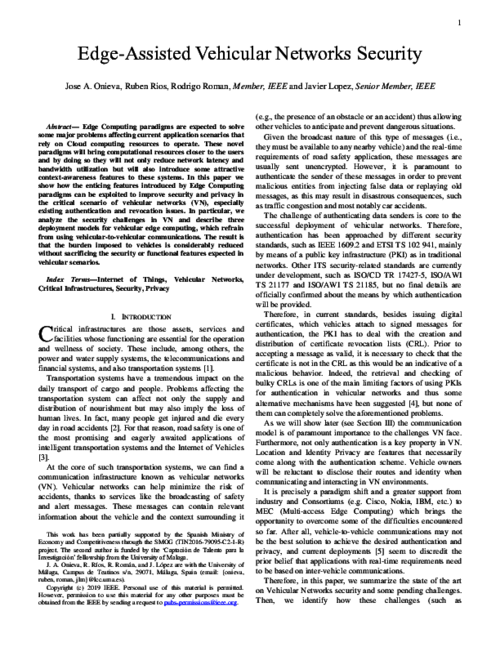
Information Security Technical Report, vol. 12, no. 3, Elsevier, pp. 179-185, 2007. DOI
Abstract
Spam is a big problem for email users. The battle between spamming and anti-spamming technologies has been going on for many years. Though many advanced anti-spamming technologies are progressing significantly, spam is still able to bombard many email users. The problem worsens when some anti-spamming methods unintentionally filtered legitimate emails instead! In this paper, we first review existing anti-spam technologies, then propose a layered defense framework using a combination of anti-spamming methods. Under this framework, the server-level defense is targeted for common spam while the client-level defense further filters specific spam for individual users. This layered structure improves on filtering accuracy and yet reduces the number of false positives. A sub-system using our pre-challenge method is implemented as an add-on in Microsoft Outlook 2002. In addition, we extend our client-based pre-challenge method to a domain-based solution thus further reducing the individual email users’ overheads.
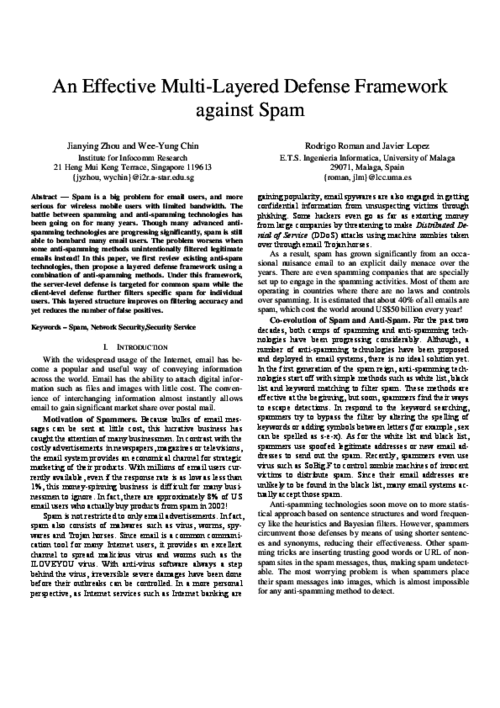
Wireless Communications and Mobile Computing, vol. 12, Wiley, pp. 133-143, Jan 2012. DOI
Abstract
Wireless sensors are battery-powered devices which are highly constrained in terms of computational capabilities, memory and communication bandwidth. While battery life is their main limitation, they require considerable energy to communicate data. Due to this, it turns out that the energy saving of computationally inexpensive primitives (like symmetric key cryptography (SKC)) can be nullified by the bigger amount of data they require to be sent. In this work, we study the energy cost of key agreement protocols between peers in a network using asymmetric key cryptography. Our main concern is to reduce the amount of data to be exchanged, which can be done by using special cryptographic paradigms like identity-based and self-certified cryptography. The main news is that an intensive computational primitive for resource-constrained devices, such as non-interactive identity-based authenticated key exchange, performs comparably or even better than traditional authenticated key exchange (AKE) in a variety of scenarios. Moreover, protocols based in this primitive can provide better security properties in real deployments than other simple protocols based on symmetric cryptography. Our findings illustrate to what extent the latest implementation advancements push the efficiency boundaries of public key cryptography (PKC) in wireless sensor networks (WSNs).

III Simposio Español de Comercio Electrónico, pp. 95-104, June, 2005.
Abstract
Los sistemas electrónicos de pago permiten que un comprador adquiera a un vendedor una serie de productos y servicios de forma virtual. Sin embargo, estos sistemas no tienen en cuenta el escenario en el que un comprador se convierte en donante, accediendo al servicio de forma gratuita. En este artículo se presenta el concepto y características de las microdonaciones, o la donación de cantidades tan pequeñas como un céntimo de euro en el contexto del comercio electrónico. También se muestra como la microdonación es algo necesario en el contexto actual de Internet, y como es posible su implementación basándose en sistemas de micropago.
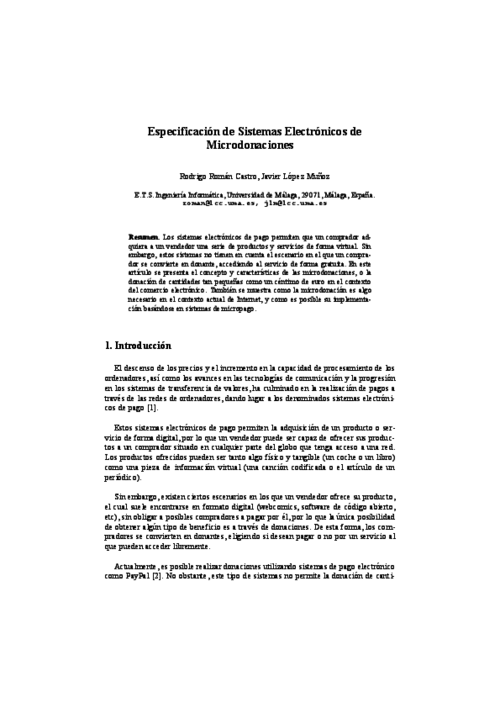
X Reunión Española sobre Criptología y Seguridad de la Información (RECSI’08), pp. 231-236, September, 2008.
Abstract
Wireless sensors are battery-powered devices which are highly constrained in terms of computational capabilities, memory, and communication bandwidth. While battery life is their main limitation, they require considerable energy to communicate data. Due to this, the energy saving of computationally inexpensive security primitives (like those using symmetric key cryptography) can be nullified by the bigger amount of data they require to be sent. In this work we study the energy cost of key agreement protocols between peers in a network using public key cryptography techniques. Our concern is to reduce the amount of data to be exchanged. Our main news is that a computationally very demanding security primitive, such as identity-based authenticated key exchange, can present energy-wise a better performance than traditional public key based key exchange in realistic scenarios such as Underwater Wireless Sensor Networks. Such a result is not to be expected in wired networks.
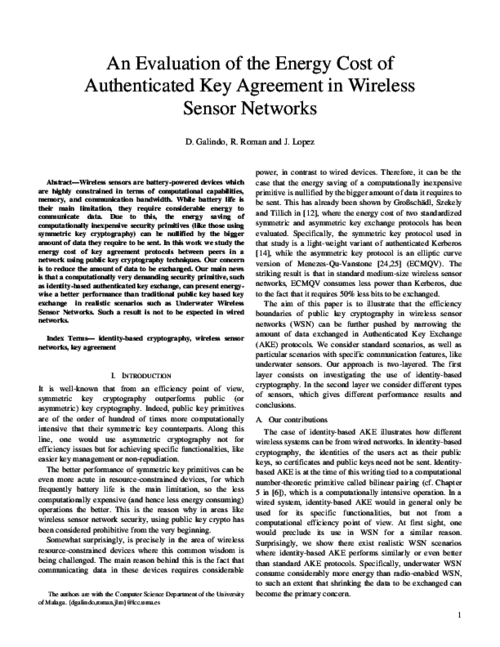
IEEE Computer, vol. 51, issue 7, IEEE Computer Society, pp. 16-25, 07/2018. DOI
5th Symposium on Signal Processing and Information Technology (ISSPIT’05), IEEE, pp. 472-477, 2005.
Abstract
Digital Rights Management (DRM) is an umbrella term for any of several arrangements which allows a vendor of content in electronic form to control the material and restrict its usage in various ways that can be specified by the vendor. These arrangements are provided through security techniques, mainly encryption, and the distribution, in a detached manner, of content and rights. This allows free access to the content by the consumers, but only those carrying the proper Right Object (RO) will be able to process such content. As a security service considered in different layers of the security framework defined by ITU X.805, almost all applications need to consider non-repudiation in the very beginning of their design. Unfortunately this has not been done so far in DRM specifications due to practical issues and the type of content distributed. We analyze this service for the a DRM framework and provide a solution which allows the right objects acquisition to be undeniable.
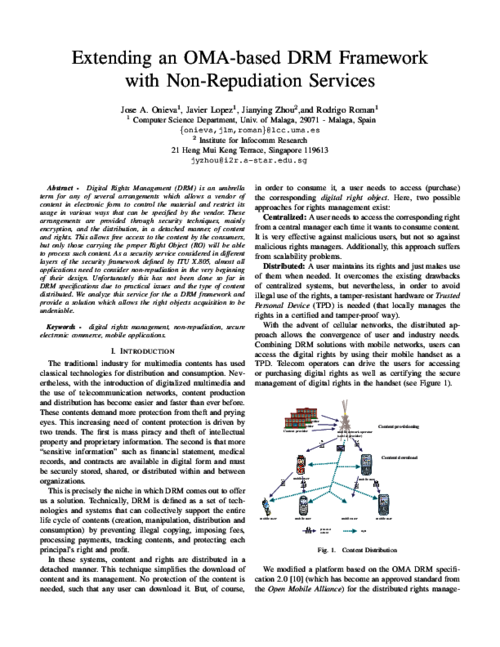
IX Reunion Española sobre Criptologia y Seguridad de la Informacion (RECSI’06), UOC S.L., pp. 129-141, 2006.
Abstract
Digital Rights Management (DRM) es un término general para cualesquiera de las soluciones que permite a un vendedor de contenido en forma electrónica controlar el material y restringir su uso de distintas maneras. Estas soluciones son posibles, por un lado gracias a técnicas de la Seguridad de la Información, principalmente cifrado de datos, y por otro a la distribución, de manera independiente, de contenido y derechos digitales. Esto permite que los consumidores puedan acceder libremente al contenido, pero sólo aquellos que adquieran el derecho digital apropiado (RO) podrán procesarlo. Como servicio de seguridad considerado en diversas capas del marco de seguridad definido por la recomendación ITU X.805, casi todas las aplicaciones necesitan considerar la propiedad de no repudio en las etapas iniciales de su diseño. Desafortunadamente, esto no ha sido así en general, y más concretamente en especificaciones DRM; debido a consideraciones en la práctica y al tipo de contenido a distribuir. Analizamos este servicio para un marco de DRM y proporcionamos una solución que permita que la adquisición de derechos digitales sea un operación que no pueda repudiarse.
